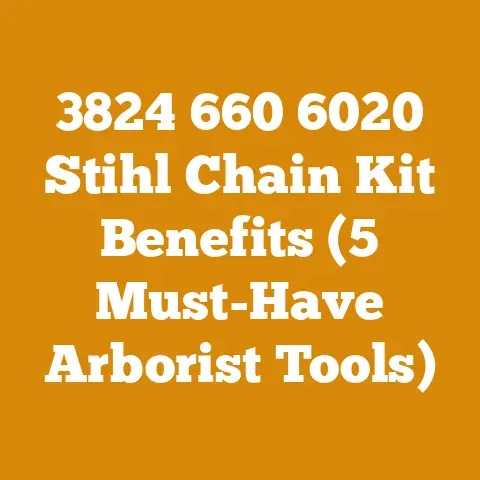Tractor Supply Weed Wacker: Cub Cadet Walk-Behind Review (Pro Tips)
I understand the frustration of battling unruly weeds and overgrown brush, especially when dealing with larger properties. A walk-behind brush mower, like the Cub Cadet models available at Tractor Supply, can be a game-changer. This review isn’t just about the machine itself; it’s about maximizing its potential and making informed decisions. I’ll share my experiences, pro tips, and insights into using these powerful tools effectively and safely.
Understanding Walk-Behind Brush Mowers
Before diving into the specifics of the Cub Cadet walk-behind brush mower, let’s define what these machines are and why they’re useful in the world of wood processing and land management.
- Definition: A walk-behind brush mower is a self-propelled machine designed to clear dense vegetation, including thick grass, weeds, brush, and even small saplings. Unlike standard lawn mowers, brush mowers are built with heavy-duty components to withstand tougher conditions.
- Key Features: Look for features like a powerful engine (typically gas-powered), high-strength blades, durable construction, and adjustable cutting heights. These mowers often have large wheels for navigating uneven terrain.
- Applications: Walk-behind brush mowers are ideal for clearing overgrown fields, maintaining trails, preparing land for logging or construction, and managing vegetation in areas where tractors or larger equipment can’t reach.
- Relevance to Wood Processing: In wood processing, these mowers are incredibly useful for clearing underbrush around logging sites, creating firebreaks, and maintaining access roads. A clear worksite is a safe worksite!
The Cub Cadet Walk-Behind Brush Mower Lineup at Tractor Supply
Tractor Supply Company (TSC) is a popular retailer for outdoor power equipment, and they often carry Cub Cadet walk-behind brush mowers. Cub Cadet is a well-known brand in the lawn and garden industry, known for producing robust and reliable machines. The specific models available at TSC may vary depending on the season and location, but typically, you’ll find a range of options with different engine sizes and cutting widths.
- Popular Models: Some Cub Cadet models I’ve seen frequently at TSC include the Cub Cadet BC280 and the BC210. These models usually feature Briggs & Stratton engines, self-propelled drive systems, and various cutting height adjustments.
- Considerations When Choosing: When selecting a Cub Cadet walk-behind brush mower, I always consider the following factors:
- Engine Size: A larger engine (measured in horsepower or cubic centimeters) will provide more power for cutting through dense vegetation.
- Cutting Width: A wider cutting width will allow you to clear larger areas more quickly, but it may also make the mower more difficult to maneuver in tight spaces.
- Drive System: Self-propelled models are essential for tackling hills and uneven terrain. Look for models with multiple speed settings.
- Wheel Size: Larger wheels provide better traction and stability on rough ground.
- Cutting Height Adjustment: Adjustable cutting heights allow you to customize the mower to the specific vegetation you’re dealing with.
- Warranty and Support: Always check the warranty offered by Cub Cadet and the return policy at Tractor Supply. Having access to reliable customer support is crucial if you encounter any issues with your mower.
Unboxing and Initial Setup: Getting Started Right
The initial setup is critical for ensuring the longevity and optimal performance of your Cub Cadet brush mower. I’ve seen too many people skip steps and end up with problems down the road.
- Inventory and Inspection: Carefully unpack the mower and check for any damage that may have occurred during shipping. Verify that all the listed components are included. Don’t just assume everything is there; I once received a mower with a missing spark plug!
- Assembly: Most walk-behind brush mowers require some minor assembly, such as attaching the handlebar or adding the cutting deck. Follow the manufacturer’s instructions closely. Don’t force anything; if something doesn’t fit easily, double-check the instructions.
- Fluid Levels: Before starting the engine, check the oil level and add oil as needed. Use the type of oil recommended in the owner’s manual. Also, fill the fuel tank with fresh gasoline. I recommend using fuel stabilizer, especially if you don’t plan to use the mower frequently.
- Tire Pressure: Check the tire pressure and inflate the tires to the recommended pressure. Proper tire pressure will improve traction and handling.
- Initial Start-Up: Follow the manufacturer’s instructions for starting the engine. Typically, this involves priming the engine, setting the choke, and pulling the starter cord. Be patient; it may take a few tries to get the engine started for the first time.
- Safety Check: Before using the mower, perform a thorough safety check. Ensure that all guards and shields are in place and that the blades are properly secured.
Pro Tips for Operating Your Cub Cadet Brush Mower
Operating a walk-behind brush mower safely and effectively requires more than just starting the engine and pushing it forward. Here are some pro tips I’ve learned over the years:
- Safety First:
- Personal Protective Equipment (PPE): Always wear appropriate PPE, including safety glasses, hearing protection, gloves, and sturdy boots. Brush mowers can throw debris at high speeds, so eye protection is essential.
- Clear the Area: Before mowing, clear the area of any rocks, branches, or other debris that could damage the mower or become projectiles.
- Be Aware of Your Surroundings: Pay attention to your surroundings and watch out for obstacles, such as fences, trees, and underground utilities.
- Never Operate on Steep Slopes: Walk-behind brush mowers can be unstable on steep slopes. Avoid mowing on slopes that are too steep for safe operation.
- Keep Bystanders Away: Keep children, pets, and other bystanders away from the mowing area.
- Mowing Techniques:
- Start High: Begin by setting the cutting height to the highest setting and gradually lower it as needed. This will prevent the mower from bogging down in thick vegetation.
- Overlap Passes: Overlap each pass slightly to ensure that you’re cutting all the vegetation.
- Mow in a Pattern: Mow in a consistent pattern to avoid missing areas.
- Vary Your Direction: Vary your mowing direction to prevent the vegetation from being flattened in one direction.
- Avoid Wet Vegetation: Avoid mowing when the vegetation is wet, as this can cause the mower to clog.
- Maintenance:
- Clean the Mower: After each use, clean the mower to remove any grass, dirt, or debris. Use a brush or a garden hose to clean the cutting deck and engine.
- Sharpen the Blades: Sharpen the blades regularly to ensure that they are cutting efficiently. Dull blades can tear the vegetation, which can damage the mower and reduce its performance.
- Check the Oil Level: Check the oil level regularly and add oil as needed.
- Replace the Air Filter: Replace the air filter regularly to ensure that the engine is running properly.
- Lubricate Moving Parts: Lubricate all moving parts, such as the wheels and axles, to keep them operating smoothly.
- Store the Mower Properly: Store the mower in a dry, protected area when not in use.
Case Study: Clearing a Logging Landing
I was once contracted to clear a logging landing for a small-scale timber operation. The landing was overgrown with thick brush and small trees, making it difficult to maneuver the logging equipment. I used a Cub Cadet BC280 walk-behind brush mower to clear the area.
- Challenge: The dense vegetation made it difficult to see the ground, and there were several hidden obstacles, such as rocks and stumps.
- Solution: I started by setting the cutting height to the highest setting and mowing in a grid pattern. I overlapped each pass to ensure that I was cutting all the vegetation. I also used a metal detector to locate any hidden obstacles.
- Results: The Cub Cadet brush mower was able to clear the logging landing quickly and efficiently. The logging crew was able to move their equipment onto the landing without any problems. The brush mower saved the timber operation a lot of time and money.
- Lessons Learned: Always take the time to clear the area of any obstacles before mowing. Use a metal detector to locate any hidden objects. Overlap each pass to ensure that you’re cutting all the vegetation.
Choosing the Right Blade for Your Cub Cadet Brush Mower
The type of blade you use on your Cub Cadet brush mower can significantly impact its performance. Different blades are designed for different types of vegetation.
- Standard Blades: Standard blades are typically used for mowing grass and light weeds. They are relatively inexpensive and easy to sharpen.
- Brush Blades: Brush blades are designed for cutting through thicker vegetation, such as brush, small trees, and vines. They are made from heavier-gauge steel and have a more aggressive cutting edge.
- Chipper Blades: Chipper blades are designed for chipping small branches and twigs. They have a series of teeth that shred the vegetation into small pieces.
- Choosing the Right Blade: When selecting a blade, consider the type of vegetation you’ll be cutting. If you’re only mowing grass and light weeds, a standard blade will suffice. If you’re cutting through thicker vegetation, you’ll need a brush blade or a chipper blade.
- Blade Maintenance: Keep your blades sharp and balanced. Dull blades can tear the vegetation and damage the mower. Unbalanced blades can cause the mower to vibrate excessively, which can damage the engine.
Troubleshooting Common Problems
Even with proper maintenance, you may encounter some common problems with your Cub Cadet brush mower. Here are some troubleshooting tips:
- Engine Won’t Start:
- Check the Fuel: Make sure the fuel tank is full and that the fuel is fresh.
- Check the Spark Plug: Clean or replace the spark plug.
- Check the Air Filter: Clean or replace the air filter.
- Check the Fuel Filter: Replace the fuel filter.
- Engine Runs Rough:
- Check the Spark Plug: Clean or replace the spark plug.
- Check the Air Filter: Clean or replace the air filter.
- Check the Fuel Filter: Replace the fuel filter.
- Adjust the Carburetor: Adjust the carburetor according to the manufacturer’s instructions.
- Mower Won’t Cut:
- Sharpen the Blades: Sharpen the blades.
- Check the Belt: Make sure the belt is properly tensioned and that it is not worn or damaged.
- Check the Blade Adapter: Make sure the blade adapter is not damaged or worn.
- Mower Vibrates Excessively:
- Balance the Blades: Balance the blades.
- Check the Blade Adapter: Make sure the blade adapter is not damaged or worn.
- Check the Engine Mounts: Make sure the engine mounts are not loose or damaged.
The Importance of Regular Maintenance
Regular maintenance is essential for keeping your Cub Cadet walk-behind brush mower running smoothly and efficiently. A well-maintained mower will last longer, perform better, and be safer to operate.
- Daily Maintenance:
- Check the Oil Level: Check the oil level before each use and add oil as needed.
- Check the Air Filter: Clean the air filter after each use.
- Clean the Mower: Clean the mower after each use to remove any grass, dirt, or debris.
- Weekly Maintenance:
- Sharpen the Blades: Sharpen the blades weekly or more often if needed.
- Check the Tire Pressure: Check the tire pressure and inflate the tires to the recommended pressure.
- Lubricate Moving Parts: Lubricate all moving parts, such as the wheels and axles.
- Monthly Maintenance:
- Replace the Air Filter: Replace the air filter monthly or more often if needed.
- Replace the Fuel Filter: Replace the fuel filter monthly or more often if needed.
- Check the Spark Plug: Check the spark plug and replace it if needed.
- Annual Maintenance:
- Change the Oil: Change the oil annually or more often if needed.
- Inspect the Belts: Inspect the belts for wear and tear and replace them if needed.
- Inspect the Hoses: Inspect the hoses for cracks or leaks and replace them if needed.
- Tune Up the Engine: Tune up the engine according to the manufacturer’s instructions.
Extending the Life of Your Brush Mower
Beyond regular maintenance, there are several things you can do to extend the life of your Cub Cadet walk-behind brush mower.
- Store the Mower Properly: Store the mower in a dry, protected area when not in use. This will protect it from the elements and prevent rust and corrosion.
- Use Fuel Stabilizer: Use fuel stabilizer in the fuel tank, especially if you don’t plan to use the mower frequently. Fuel stabilizer will prevent the fuel from breaking down and clogging the carburetor.
- Avoid Overloading the Mower: Avoid overloading the mower by trying to cut through vegetation that is too thick or dense. This can damage the engine and the blades.
- Use the Mower for Its Intended Purpose: Use the mower for its intended purpose. Don’t use it to cut down trees or to clear land.
- Follow the Manufacturer’s Instructions: Follow the manufacturer’s instructions for operating and maintaining the mower. This will help you to get the most out of your mower and to avoid any problems.
Strategic Advantages of Using a Walk-Behind Brush Mower
Using a walk-behind brush mower offers several strategic advantages in wood processing and land management.
- Increased Efficiency: Brush mowers can clear large areas of vegetation quickly and efficiently, saving you time and labor.
- Improved Safety: Clearing vegetation can improve safety by reducing the risk of fire and by making it easier to see obstacles.
- Enhanced Access: Brush mowers can clear vegetation to create access roads and trails, making it easier to transport equipment and materials.
- Reduced Costs: Using a brush mower can reduce the need for manual labor, saving you money on labor costs.
- Environmental Benefits: Clearing vegetation can improve the health of the forest by reducing competition for resources and by promoting new growth.
Financial Considerations: Cost vs. Benefit
Investing in a Cub Cadet walk-behind brush mower is a significant decision, so it’s essential to weigh the costs against the benefits.
- Initial Cost: The initial cost of a walk-behind brush mower can range from a few hundred dollars to several thousand dollars, depending on the model and features.
- Operating Costs: Operating costs include fuel, oil, and maintenance. Fuel costs will vary depending on the size of the engine and the amount of use. Oil and maintenance costs will depend on how well you maintain the mower.
- Labor Costs: Using a brush mower can reduce the need for manual labor, saving you money on labor costs.
- Time Savings: Brush mowers can clear large areas of vegetation quickly and efficiently, saving you time.
- Increased Productivity: Clearing vegetation can improve productivity by making it easier to transport equipment and materials.
- Return on Investment (ROI): To determine the ROI of a brush mower, you’ll need to consider the initial cost, operating costs, labor savings, time savings, and increased productivity. In many cases, a brush mower can pay for itself in a relatively short period of time. I have seen cases where the machine has paid for itself in a few months of heavy use.
Safety Standards and Regulations
Operating a walk-behind brush mower safely requires adherence to safety standards and regulations.
- ANSI Standards: The American National Standards Institute (ANSI) develops safety standards for outdoor power equipment, including walk-behind brush mowers. These standards cover topics such as machine design, guarding, and operator training.
- OSHA Regulations: The Occupational Safety and Health Administration (OSHA) sets regulations for workplace safety, including the use of outdoor power equipment. These regulations cover topics such as PPE, machine guarding, and training.
- Local Regulations: Some local jurisdictions may have additional regulations regarding the use of outdoor power equipment. Be sure to check with your local authorities to ensure that you are in compliance with all applicable regulations.
- Manufacturer’s Recommendations: Always follow the manufacturer’s recommendations for operating and maintaining your walk-behind brush mower. This will help you to avoid any accidents or injuries.
The Future of Brush Mowing Technology
The technology behind walk-behind brush mowers is constantly evolving. Here are some trends to watch for in the future:
- Electric Brush Mowers: Electric brush mowers are becoming increasingly popular as battery technology improves. Electric mowers are quieter, cleaner, and easier to maintain than gas-powered mowers.
- Robotic Brush Mowers: Robotic brush mowers are becoming more sophisticated and capable of clearing large areas of vegetation autonomously.
- GPS-Guided Brush Mowers: GPS-guided brush mowers can be programmed to follow specific routes, making them ideal for clearing trails and maintaining firebreaks.
- Advanced Blade Technology: New blade designs are being developed to improve cutting efficiency and reduce the risk of damage to the mower.
- Smart Mowers: Smart mowers are equipped with sensors and software that can monitor the mower’s performance and provide alerts when maintenance is needed.
Next Steps: Getting Started with Your Brush Mowing Project
If you’re ready to start your own brush mowing project, here are some practical next steps:






